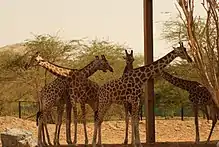Nubian giraffe
The Nubian giraffe (Giraffa camelopardalis camelopardalis) is the nominate subspecies of giraffe. It is found in Ethiopia, Kenya, Uganda, South Sudan and Sudan. It is currently extinct in the wild of the Democratic Republic of Congo, Egypt and Eritrea. The Nubian giraffe used to be widespread everywhere on Northeast Africa. The subspecies was listed as Critically Endangered by the IUCN in 2018 for the first time due to a 95% decline in the past 3 decades.[2]
| Nubian giraffe | |
|---|---|
%252C_crop_%2526_flip.jpg.webp) | |
| A Nubian giraffe of the original phenotype at Al Ain Zoo in the United Arab Emirates | |
| Scientific classification | |
| Kingdom: | Animalia |
| Phylum: | Chordata |
| Class: | Mammalia |
| Order: | Artiodactyla |
| Family: | Giraffidae |
| Genus: | Giraffa |
| Species: | G. camelopardalis |
| Subspecies: | G. c. camelopardalis |
| Trinomial name | |
| Giraffa camelopardalis camelopardalis | |
 | |
| Range in purple | |
| Synonyms | |
|
G. c. rothschildi | |
Taxonomy and evolution
The IUCN currently recognizes only one species of giraffe with nine subspecies, one of which is the Nubian giraffe.[1] The Nubian giraffe, along with the whole species, were first known by the binomen Cervus camelopardalis described by Swedish zoologist Carl Linnaeus in the Systema Naturæ per regna tria naturæ, secundum classes, ordines, genera, species, cum characteribus, differentiis, synonymis, locis in 1758. He described the giraffe from Ethiopia or Sennar of Eastern Sudan.[3]
A 2016 analysis of giraffe subspecies proposed that the Rothschild's giraffe (G. c. rothschildi) could be considered a conspecific ecotype of the Nubian giraffe,[4] but these results are not definitive.[5]
Following Linnaeus's description of the Nubian giraffe, several specimens were described by other naturalists and zoologists since the end of the 18th century under different scientific names, which are all considered synonyms of Giraffa camelopardalis camelopardalis today:
- G. c. aethiopicus by Ogilby, 1836
- G. c. senaariensis by Trouessart, 1898
- G. c. typica by Bryden, 1899[3]
- G. c. rothschildi by Lydekker, 1903[4]
- G. c. congoensis by Lydekker, 1903[3]
Physical description
The Nubian giraffe has sharply defined chestnut-colored spots surrounded by mostly white lines, while undersides lack spotting. The median lump is particularly developed in the male giraffe.[6]
Habitat population
Giraffes occurred everywhere in Africa; the Nubian giraffe was widespread throughout North Africa, from Kenya to Egypt. The giraffe lives in savannahs and woodlands. The Nubian giraffe currently lives in eastern South Sudan and southwestern Ethiopia, and isolated pockets in Uganda and Kenya. It was estimated in 2010 that fewer than 250 live in the wild, although this number was uncertain.[7] However, as of 2016, it was recently estimated that 2,150 Nubian giraffes live in the wild, 1,500 of those of the Rothschild's ecotype.[8]Fewer than 200 now live in western Ethiopia and about 450 in eastern South Sudan. There are 800 in Kenya and more than 1,550 in Uganda.[9]
In captivity

The Nubian giraffe is, due to the introduction of the Rothschild's giraffe into its subspecies, one of the most common giraffe types present in captivity, in conjunction with the reticulated giraffe. However, the original phenotype is rare, as the Al Ain Zoo from the United Arab Emirates is the only known zoo outside of Africa to be breeding the endangered original phenotype.[11][12] The Nubian giraffe is also breeding in captivity in Giza Zoo, Egypt.
See also
- Zarafa (giraffe), the most famous of three Nubian giraffes gifted from Muhammad Ali of Egypt to European rulers in 1827
References
- Wube, T., Doherty, J.B., Fennessy, J. & Marais, A. (2018). "Giraffa camelopardalis ssp. camelopardalis". IUCN Red List of Threatened Species. 2018: e.T88420707A88420710.CS1 maint: uses authors parameter (link)
- "Northern giraffe: Giraffa camelopardalis". Giraffe Conservation Foundation. 2019-03-14. Retrieved 2020-11-19.
- Linnaeus, C. (1758). Nubian giraffe (Giraffa camelopardalis camelopardalis). Catalogue of the ungulate mammals in the British Museum (Natural History) (1913): 242.
- Fennessy, J; Bidon, T; Reuss, F; Kumar, V; Elkan, P; Nilsson, MA; Vamberger, M; Fritz, U; Janke, A (September 8, 2016). "Multi-locus Analyses Reveal Four Giraffe Species Instead of One". Current Biology. 26 (18): 2543–2549. doi:10.1016/j.cub.2016.07.036. PMID 27618261.
- Bercovitch, Fred B.; Berry, Philip S. M.; Dagg, Anne; Deacon, Francois; Doherty, John B.; Lee, Derek E.; Mineur, Frédéric; Muller, Zoe; Ogden, Rob (2017-02-20). "How many species of giraffe are there?". Current Biology. 27 (4): R136–R137. doi:10.1016/j.cub.2016.12.039. ISSN 0960-9822. PMID 28222287.
- Seymour, R. (2002) The taxonomic status of the giraffe, Giraffa camelopardalis (L. 1758), PH.D Thesis
- "Giraffe – The Facts: Current giraffe status?". Giraffe Conservation Foundation. Archived from the original on 19 March 2016. Retrieved 21 December 2010.
- Jordan Carlton Schaul (17 June 2014). "Safeguarding Giraffe Populations From Extinction in East Africa". nationalgeographic.com. Retrieved 8 July 2015.
- "Northern giraffe: Giraffa camelopardalis". Giraffe Conservation Foundation. 2019-03-14. Retrieved 2020-11-19.
- "Nubian Giraffe Giraffa camelopardalis camelopardalis" (PDF). 2011. Retrieved 8 July 2015. Cite journal requires
|journal=(help) - "Exhibits". Al Ain Zoo. 25 February 2003. Archived from the original on 29 November 2011. Retrieved 21 November 2011.
- "Nubian giraffe born in Al Ain zoo". UAE Interact. Archived from the original on 20 March 2012. Retrieved 21 December 2010.
External links
 Media related to Nubian Giraffes at Wikimedia Commons
Media related to Nubian Giraffes at Wikimedia Commons Data related to Giraffa camelopardalis camelopardalis at Wikispecies
Data related to Giraffa camelopardalis camelopardalis at Wikispecies
